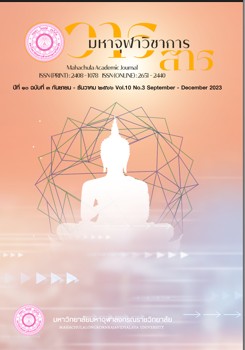Guidelines for Conserving Sri Tri Phum Stupa in Nikhom Phatthana Subdistrict, Mueang District, Lampang Province
Main Article Content
Abstract
This thesis undertakes three main objectives: (1) the study of pagodas in Buddhism, (2) the examination of the conservation practices applied to pagodas in Buddhism, and (3) the proposal of conservation guidelines specifically for the Sri Trai Phum Pagoda located in the Nikhom Phatthana Sub-district, Mueang District, Lampang Province.
The research methodology employed for this study was qualitative in nature and involved the analysis of documents and interviews with thirteen key informants. Findings from the research demonstrate that pagodas in Buddhism were constructed with the purpose of housing relics of the Buddha, individual Buddhas, noble disciples, and emperors. The initial pagodas or stupas built during the Buddha's time were constructed in accordance with the Buddha's four sacred places: the Birth Place, Enlightenment, the First Sermon, and Nibbana. Over time, additional pagodas known as the four Buddha-Chediyas emerged, namely Dhatu-chetiya, Paribhoga-chetiya, Dhamma-chetiya, and Uddesika-chetiya. These pagodas became highly valued symbols of Buddhism forworship and were considered central to Buddhist faith, leading to the preservation of pagodas in Buddhism. The research also discovered that King Ashoka the Great played a crucial role in the preservation, restoration, and construction of pagodas and monasteries during a later period. Architectural additions such as guardian sculptures and giant sculptures surrounding the pagodas were believed to protect them. In terms of conservation, academic principles were employed to prevent deterioration, preserve, strengthen, restore, replicate, reconstruct, and apply appropriate measures. Effective conservation processes began with a comprehensive study, understanding, and evaluation of the significance and impact of pagoda conservation. Guidelines for the preservation of Chedi Sri Trai Phum in the Nikhom Phatthana Sub-district, Mueang District, Lampang Province emphasize the importance of proper knowledge and understanding surrounding the preservation process, which should align academically and with Buddhist principles. Furthermore, efforts should be made to instill Buddhist consciousness and appreciation in the younger generation, fostering a cooperative network among temples, homes, schools, and public and private sectors to ensure the conservation and recognition of the cultural and religious value of pagodas. This approach will ultimately contribute to the sustainability and preservation of pagodas as a significant inheritance of religion and a continuation of unique cultural traditions in the local context.
Article Details

This work is licensed under a Creative Commons Attribution-NonCommercial-NoDerivatives 4.0 International License.
References
ชัยณรงค์ ดีอินทร์. “รูปแบบเจดีย์เหลี่ยมย่อมุม สมัยรัตนโกสินทร์ตอนต้น (ระหว่างสมัยรัชกาลที่ ๑-๓”. วิทยานิพนธ์ศิลปศาสตรมหาบัณฑิต. ประวัติศาสตร์สถาปัตยกรรม. บัณฑิตวิทยาลัย: มหาวิทยาลัยศิลปากร, ๒๕๓๔.
ปิยวรรณ หอมจันทร์ และคณะ. “กระบวนการอนุรักษ์ศาสนสถานในมรดกโลกทางวัฒนธรรมของไทย”. วารสาร มจร การพัฒนาสังคม. ปีที่ ๕ ฉบับที่ ๓ (กันยายน-ธันวาคม ๒๕๖๓) : ๓๘-๔๐.
พระมหากฤษธิชัย กิตฺติธมฺโม. “การอนุรักษ์สถาปัตยกรรมในพระไตรปิฎก”. พุทธจักร. ปีที่ ๗๕ ฉบับที่ ๒ (พฤษภาคม-มิถุนายน ๒๕๖๔) : ๖๓-๗๐.
พระมหาสิงขร ปริยตฺติเมธี. “พระพุทธศาสนาในรัชสมัยพระ”. วารสารพุทธมัคค์. ปีที่ ๑ ฉบับที่ ๑ (มกราคม-มิถุนายน ๒๕๕๙) : ๔๑.
พระรังสรรค์ จนฺทสีโล. “แนวทางในการอนุรักษ์ศาสนสถานวัดพระธาตุดอยถ้ำของชุมชน ตำบลน้ำแพร่ อำเภอหางดง จังหวัดเชียง”. พิฆเนศวร์สาร. ปีที่ ๑๓ ฉบับที่ ๒ (กรกฎาคม-ธันวาคม ๒๕๖๐) : ๔๘-๔๙.
มหาจุฬาลงกรณราชวิทยาลัย. พระไตรปิฎกภาษาไทย ฉบับมหาจุฬาลงกรณราชวิทยาลัย. กรุงเทพมหานคร: โรงพิมพ์มหาจุฬาลงกรณราชวิทยาลัย, ๒๕๓๙.
_________. พระไตรปิฎกภาษาบาลี ฉบับมหาจุฬาเตปิฏกํ ๒๕๐๐. กรุงเทพมหานคร: โรงพิมพ์มหาจุฬาลงกรณราชวิทยาลัย, ๒๕๓๕.
รัฏฐา ฤทธิศร. “การศึกษาพัฒนาการของเจดีย์ล้านนา”. วิทยานิพนธ์ศิลปศาสตรมหาบัณฑิต, ประวัติศาสตร์สถาปัตยกรรม. บัณฑิตวิทยาลัย: มหาวิทยาลัยศิลปากร, ๒๕๔๑.
สมชาติ จึงสิริอารักษ์. “ความเชื่อและแนวความคิดในการอนุรักษ์โบราณสถานของไทยจากอดีตสู่ปัจจุบัน”. หน้าจั่ว ว่าด้วยประวัติศาสตร์สถาปัตยกรรมและสถาปัตยกรรมไทย. ปี ๒๕๕๕ ฉบับที่ ๘ (กันยายน ๒๕๕๕-สิงหาคม ๒๕๕๖) : ๘.
สมชาย เปรมจิตต์และคณะ. พระเจดีย์ในลานนาไทย. งานวิเคราะห์และอนุรักษ์ศิลปะและสถาปัตยกรรมลานนาไทย. โครงการศึกษาวิจัยศิลปะสถาปัตยกรรมลานนา สถาบันวิจัยสังคม: มหาวิทยาลัยเชียงใหม่, ๒๕๒๔.
สมเด็จพระเจ้าบรมวงศ์เธอ กรมพระยาดำรงราชานุภาพ. ตำนานพระพุทธเจดีย์. พิมพ์ครั้งที่ ๖. พระนคร: ห้างหุ้นส่วนจำกัด ศิวพร, ๒๕๑๐.
Engelhardt Richard A. “Special Singificance of the World Heritage Sites of Religious Interest-Key issues Concerning their Protection, Conservation, Restoration, and Management)”. International Consultative Workshop on the Conservation and Management of the World Heritage of religious interest in Asia-Pacific, (Bangkok and Nakhon Phanom Province, 17-19 May 2017) : 5.
Nguyen Loan. “Conservation, and Management of Sacred Cultural Landscape Sites in Asia”, International Consultative Workshop on the Conservation and Management of the World Heritage of religious interest in Asia-Pacific, (Bangkok and Nakhon phanom Province, 17-19 May 2017) : 10.
Oo Tan Saw. “Living Religious Heritage Properties in Asia: Restoration, Reconstruction and Redesign”. International Consultative Workshop on the Conservation and Management of the World Heritage of religious interest in Asia-Pacific, (Bangkok and Nakhon Phanom Province, 17-19 May 2017) : 9.
Rll Hae Un. “Special Singificance of the World Heritage Sites of Religious Interest-Key issues Concerning their Protection, Conservation, Restoration, and Management)”. International Consultative Workshop on the Conservation and Management of the World Heritage of religious interest in Asia-Pacific, (Bangkok and Nakhon phanom Province, 17-19 May 2017) : 4.
Sidorenko, A. “Implementation of the UNESCO Initiative on Heritage of Religious Interest”. International Consultative Workshop on the Conservation and Management of the World Heritage of religious interest in Asia-Pacific. (Bangkok and Nakhon phanom Province, 17-19 May 2017) : 3.
พระเทพวัชรบัณฑิต. “การอนุรักษ์และการจัดการปูชนียสถาน”. [ออนไลน์]. แหล่งที่มา: https://www. mcu. ac.th/article/detail/35374 [๒๒ พฤศจิกายน ๒๕๖๕].
พระมหาสมจินต์ สมฺมาปญฺโญ. การสร้างเจดีย์เป็นพุทธประสงค์. [ออนไลน์]. แหล่งที่มา: https://www.mcu.ac.th/article/detail/503 [๒๒ พฤศจิกายน ๒๕๖๕].


